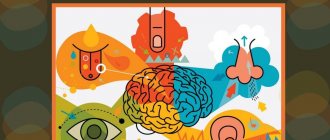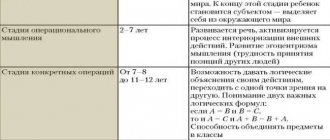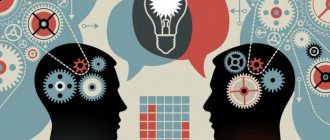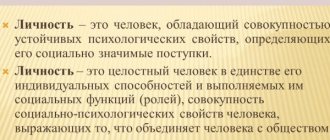Content
- Physiological mechanism of perception
- Properties of perception
- Principles of perception
- Perception factors
- Effects of perception
- Classification of types of perception
- Perceptual disturbances Illusions of perception
- Hallucinations Eidetism as a type of hallucination
If we compare the definitions of two mental processes, i.e. perceptions and sensations, then you can notice some features. For example, perception is a more complex process. If sensations reflect individual properties of objects, then perception is a holistic reflection. Thus, the result of perception is a holistic perceptual image of an object, and not a separate property of it.
Intelligence
There are a huge number of approaches to defining the concept of “intelligence”.
For most psychologists, this concept is currently associated with the ability to learn from past experience and adapt to life conditions and situations.
For some, intelligence is equivalent to a person's overall giftedness and is the sum of their overall mental abilities.
An original approach to understanding intelligence was proposed by B. G. Ananyev. He viewed intelligence as a multi-level organization of cognitive forces, covering the psychophysiological processes of the state and properties of the individual. This organization is associated “with the neurodynamic, autonomic and metabolic characteristics of a person. They are unique equivalents of intelligence and determine the measure of mental performance and the price of intellectual stress, the degree of their usefulness and harm to human health...”
Intelligence tests are usually used to assess the level of intelligence development. The most common are the Stanford-Binet and Wechsler tests.
The attitude of psychologists towards assessing intelligence using tests has not been fully determined.
Physiological mechanism of perception
The physiological basis of perception is the processes taking place in the sense organs, nerve fibers and the central nervous system. Under the influence of stimuli at the endings of the nerves present in the sensory organs, nervous excitation arises, which is transmitted along pathways to the nerve centers, and, ultimately, to the cerebral cortex. Here it enters the sensory zones of the cortex, which represent, as it were, the central projection of the nerve endings present in the sense organs. Depending on which organ the sensory zone is connected to, certain sensory information is generated.
Since perception is closely related to sensation, it can be assumed that it, like sensation, is a reflexive process. Ivan Petrovich Pavlov showed that perception is based on conditioned reflexes, i.e. temporary nerve connections formed in the cerebral cortex when receptors are exposed to objects or phenomena.
Temporary nerve connections that ensure the process of perception can be of two types: 1. Formed within the same analyzer; 2. Interanalyzer.
The first type occurs when the body is exposed to a complex stimulus of one modality (for example, a melody). The second type of neural connections formed under the influence of a complex stimulus are connections within different analyzers, the emergence of which Sechenov explained by the existence of associations. These associations in humans are necessarily accompanied by an auditory image of the word, thanks to which the perception acquires a holistic character.
Memory
Memory is an integral trace form of reflection. Memory is the basis of any mental process. Memory is one of the main forms of organization of mental life.
Based on the duration of information storage, the following levels (stages) of memory are distinguished:
- Instant memory is associated with the inertia of the senses. This memory is not subject to arbitrary control. The image in instant memory does not have constancy - it is an image of sensation, not perception. Instant memory provides a coherent perception of the world;
- Short-term memory. This is where the information that is brought to your attention is stored. Information is not stored unchanged - it is processed and interpreted. For short-term memory, voluntary control is possible through repetition or symbolization. The capacity of short-term memory is 7 units;
- Intermediate (buffer) memory is an intermediate authority between short-term and long-term memory. Here information is stored until it can be transferred to long-term memory. Clearing buffer memory and categorizing information accumulated during the day occurs during sleep;
- Long-term memory is not limited in terms of volume and time of storing information. But information cannot always be retrieved on time. The availability of information is determined by the organization of storage. There are two types of information storage in long-term memory: with random access to information (information is continuously transformed) and without random access (information is stored unchanged).
Memory processes
Imprinting begins at the stage of instant memory, deepens during the transfer of information to short-term memory, and is strengthened in long-term memory (where information is analyzed and identified).
Storage – accumulation of material in memory. Storage occurs differently for episodic (autobiographical) and semantic memory. Episodic memory stores information about various events in our lives. Semantic memory contains the rules underlying language and various mental activities. The structures characteristic of a given culture are also stored here. Semantic memory serves as a kind of framework for current life events that are stored in episodic memory.
Playback (extract). Information is always reproduced based on the structure in which it was remembered. Retrieval of information can be carried out in two ways: recognition and memory.
Since context plays a very important role in retrieving information from memory, it is always easier for a person to learn some information than to remember it. It is recognition, rather than memory, that is considered a more sensitive indicator of the actual amount of material learned.
Forgetting is a process necessary for effective memory functioning. With the help of forgetting, a person rises above the countless number of specific details and makes it easier for himself to generalize. Forgetting is difficult to manage.
Based on their origin, there are two types of memory: genetic (hereditary) and lifetime. Lifetime memory includes motor, figurative (visual, auditory, kinesthetic, etc.), emotional, symbolic (verbal and logical) and volitional memory.
Properties of perception
1. Objectivity of perception
This is the ability to reflect objects and phenomena of the real world not in the form of a set of unrelated sensations, but in the form of individual objects. Objectivity is not an innate property of perception. The emergence and improvement of this property occurs in the process of ontogenesis, starting from the first year of a child’s life. According to Ivan Mikhailovich Sechenov, objectivity is formed on the basis of movements that ensure the child’s contact with the object (hand movements; eye movements that trace the contour of the object, etc.). Without the participation of movement, images of perception would not have the quality of objectivity.
2. Integrity of perception
Perception gives a holistic image of an object. It is formed on the basis of generalization of information received in the form of various sensations about the individual properties and qualities of an object. The components of sensation are so strongly interconnected that a single complex image of an object arises even when only individual properties or individual parts of the object directly affect a person. This image arises conditionally as a result of the connection between various sensations.
The integrity of perception is expressed in the fact that even with incomplete reflection of individual properties of the perceived object, the received information is mentally completed into a holistic image of a specific object.
3. Structurality of perception
The structure of perception is not just a collection of sensations. It reflects the relationship between various properties and parts, i.e. structure of the subject. Perception brings to our consciousness the structure of an object or phenomenon that we encounter in the real world. We can say that the structure of perception is a reflection of the specific relationship of the elements of the whole. For example, notes enter consciousness, and we recognize the melody, we recognize the triangle in the figure, because we know the aspect ratio of a given figure, or a certain letter remains the same letter despite a different writing style.
Structurality is associated with another property of perception - integrity.
4. Constancy of perception
Constancy is the relative constancy of the image of an object when the conditions of its perception change (for example, a car seems large to us at any distance from it). Constancy is observed to the greatest extent in the visual perception of color, size and shape of objects. Thanks to constancy, which manifests itself in the ability of the perceptual system (a perception system that consists of a set of certain analyzers) to compensate for changes in the conditions of perception, we perceive the objects around us as relatively constant.
A person repeatedly perceives a certain object, and this object is perceived under completely different conditions. This allows the system to maintain relative constancy of the properties of objects and phenomena. Without constancy of perception, people would not be able to navigate the world around them.
5. Apperception
Apperception is the dependence of perception on past experience and personality traits of the perceiver. A person’s knowledge and previous experience play a huge role in apperception. In the process of perception, in order to classify what you perceive, you will put forward and test hypotheses about whether an object belongs to a particular category of objects.
Thus, during perception, past experience is activated. Therefore, one object can be perceived differently by different people. The content of perception is determined by the task, motives of activity, interests. An essential place in apperception is occupied by attitudes and emotions, which can easily change the content of perception.
6. Meaningfulness of perception
Meaningfulness of perception is the property of human perception to endow the perceived object with a certain meaning. Perception is not determined simply by a set of stimuli, but is a constant search for the best interpretation of the data received.
We perceive objects that have a certain meaning. Regardless of the constantly changing content, we learn the same subject. Human perception, being a kind of awareness of objects and phenomena, includes the act of understanding and comprehension.
7. Activity (selectivity) of perception
Selectivity of perception lies in the fact that at any given time we perceive only one object or a specific group of objects, while other objects in the surrounding world are the background of our perception (not reflected in consciousness).
For example, while in a lecture hall, you listen to a lecture without noticing that someone behind you is discussing plans for the evening. Your perception is directed towards the lecture until you are asked about your plans. In this case, you will already be communicating and not listening to a lecture, i.e. perception will be directed towards the interlocutors.
Study methods
In the field of psychiatry and cognitive science, the following methods are used to study the processes of memory, perception, thinking, attention and other functions:
- Recognizing figures by touch and manipulating them tactilely (Seguin board).
- Visual recognition of real, noisy, contour and defocused images (Poppelreiter test).
- Perception of objects requiring visual-spatial processing (contour geographical map, schematic clock).
- Recognizing familiar portraits of famous people.
- Listening perception and assessment of rhythmic structures.
- Detection of memory impairments (Pictogram technique).
It should be said that it is possible to identify a violation of the mental process only with the help of several methods, that is, problems need to be diagnosed in a complex manner.
The largest number of techniques explore thinking. The most famous is “Classification of Objects”, where it is possible to study various aspects of the thinking process. Also known: understanding the figurative meaning of metaphors and proverbs, solving arithmetic problems of varying degrees of complexity, comparing and defining concepts.
Now let's talk separately about the course of mental processes and states, their characteristics, properties and functions.
Principles of perception
A group of psychologists, together with Max Wertheimer, a German psychologist and founder of Gestalt psychology, formulated the laws of perception, which became the theoretical basis of Gestalt psychology.
1. The principle of proximity Elements that are close to each other in space and time and that seem to us to be united in groups, we perceive together.
2. Principle of Continuity There is a tendency to follow a direction that allows observed elements to be linked into a continuous sequence or a specific orientation. In the figure we see not just individual dots, but two intersecting lines.
3. Principle of similarity Similar elements are perceived by us together, forming closed groups. Because of the color, we perceive the points in the figure as rows rather than columns.
4. Closure principle There is a tendency to complete unfinished items and fill empty spaces.
5. The principle of simplicity (the law of content, the principle of good form, the law of pregnancy) We perceive and interpret composite or complex objects as the simplest form or a combination of the simplest forms. In the figure we see three different simple figures, and not one complex one.
Pregnant gestalt means that in any conditions we strive to see the figures as complete as possible.
6. Figure-ground
We strive to organize our perception in such a way as to see the object (figure) and the background against which it appears. The object is brighter, more significant, and noticeable.
Development of mental processes
When they talk about the development of mental processes in children, the first thing they distinguish is their age group.
From 2 to 6 years of age, the child develops mental processes. Parents can influence this if they coach them. Here are exercises you can give your children:
- Place some toys on the table. The child must remember their location and presence. Then he closes his eyes and you remove or move one of them. He must say what has changed.
- When your child has mastered this exercise, make it more difficult. Remove 2 or 3 toys.
- The following game is suitable for developing thinking: place four pictures in front of the child, where three of them relate to a specific topic. The child must guess which one is extra.
- When going to the store, give your child a list of products (3-4 to start with) to memorize. In the store he must remember them (long-term memory is trained).
If your child is 7-8 years old, he should be able to:
- Find 10 differences between objects.
- Complete the task without distraction for about 15-20 minutes.
- Copy a movement or pattern exactly.
- Complete tasks independently according to the proposed sample.
- Be able to find identical objects.
- Be able to sequence events and compose a coherent story using pictures.
- Build a logical series from a specific group of objects.
- Repeat verbatim sentences consisting of 7-8 words.
The mental processes of an adult are formed at the age of 16. But this does not mean that they cannot be trained and improved. In fact, thinking can and even needs to be developed throughout life. Therefore, in conclusion of the article, we suggest that you take one of our courses (or all of them):
- Memory development
- Logical thinking.
- Emotional intellect.
- Cognitive science
Also, be sure to practice by solving problems from our “Games, Challenges and Entertainment” section.
We wish you good luck!
We also recommend reading:
- Storytelling
- Cognitive psychology and cognitive psychotherapy
- Cognitive processes
- Intelligence and its development: several recommendations
- Sensation and perception
- Sensations: what they are and what they are like
- Exercises for memory development in preschoolers
- Cognitive sphere of personality
- Human attention: what it is and how it works
- Spheres of personality
- Two important laws of memory
Key words:1Self-knowledge
Perception factors
Our perception depends on external and internal factors.
a) External factors: - intensity of the stimulus; — size of the stimulus; — stimulus contrast; - movement of the stimulus; - recognition of the stimulus.
b) Internal factors: - human attitude; — needs; - experience; — personal characteristics (self-esteem, left- or right-handedness, optimism-pessimism, etc.); - effects of perception.
Attention
Attention is the selection and selection of relevant, personally significant signals. Like memory, attention refers to the so-called “end-to-end” mental processes, since it is present at all levels of mental organization.
Traditionally, attention is associated primarily with limiting the field of perception, that is, with such an organization of perception in which a person perceives what he wants to see (hear, etc.), anticipating the structure of the information that will be received.
Attention selects the information that will be processed. The central mechanisms of information processing in humans can deal with only one object at a given time. Fixed volume is the main characteristic of attention. Attention span cannot be changed through education and training.
The sequence of environmental analysis (direction of attention) depends on two groups of factors:
- structure of external stimuli (physical parameters of the signal: intensity, frequency, etc.);
- the structure of the internal field determined by human activity (degree of novelty, intensity of the stimulus, etc.).
Attention is accompanied by adaptive movements, but is not limited to them. The essence of attention is the selective nature of mental activity.
Attention provides direction and concentration of mental activity.
Types of attention
- involuntary, if direction and concentration are involuntary. According to K.K. Platonov, one of the forms of involuntary attention is an attitude (a state of readiness or predisposition of an individual to act in a certain way).
- voluntary, if the direction and concentration of attention are associated with a conscious goal.
Characteristics of attention
- Stability is the duration of attracting attention to the same object or to the same task. Stability is determined by peripheral factors, does not exceed 2-3 seconds, after which fluctuations in attention occur.
- Concentration of attention – increasing the intensity of the signal when the field of perception is limited.
- Distribution of attention is the subjectively experienced ability of a person to keep a certain number of heterogeneous objects in the center of attention at the same time.
- Switchability is the speed of transition from one type of activity to another (absent-mindedness - poor switchability).
- The subjectivity of attention is associated with the ability to highlight certain complexes of signals in accordance with the task at hand, personal significance, relevance of signals, etc.
Effects of perception
Let us highlight the main effects (errors) of perception:
The projection effect is the ability of people to attribute their own advantages to a pleasant person, and their shortcomings to an unpleasant person. Those. the effect suggests that other people have the same qualities as the perceiver.
The halo effect is the formation of a specific attitude towards a person through the directed attribution of certain qualities to him; information received about a person is superimposed on the image that was created in advance. Those. the effect is to extend the general opinion to the particulars.
The primacy and recency effect is the tendency of people, when faced with conflicting information about another person, to give more weight to information received first (if a stranger is perceived) or more recent information (if an old acquaintance is perceived).
The effect of physiognomic reduction is the ability of people to draw conclusions about the character and psychological characteristics of a person based on the features of his appearance.
Mental emotional processes
Let's consider each process separately.
1
Feelings
Feeling is a human emotional process that reflects a subjective evaluative attitude towards abstract or real objects. Feelings manifest differently among people because they are influenced by their own set of individual traits and personality traits. Necessary for communication, friendship and understanding of other people.
Properties of feelings:
- Content: reflection of various aspects, features of the meaning of the objects that cause them.
- Sthenicity: sthenic feelings mobilize a person’s strength, encourage him to active activity (hate, love). Asthenic paralyzes and relaxes (contempt and fear).
- Intensity: strength of feeling.
- Valence: pleasant, unpleasant and ambivalent feelings.
2
Emotions
Emotions reflect a subjective evaluative attitude towards objects, phenomena, situations and people. With the help of will, a person can evoke any emotion that he deems necessary.
The properties of emotions completely coincide with the properties of feelings.
3
Stress
Stress is a set of adaptive reactions of the psyche to stressors.
There is positive (eustress) and negative (distress) stress. The difference is in intensity: the more of it in the psyche, the worse.
4
Affects
Affects are emotional processes of an explosive nature. In many cases they are considered a negative manifestation of the psyche, but in a threatening situation they can save lives.
Classification of types of perception
1) Separation by modality: - visual perception; - auditory perception; - tactile perception; - taste perception; - olfactory perception. Combinations of different types of perception are possible.
2) Division by object of perception: - perception of space (includes the perception of size, shape, relative position of objects, their relief, distance and direction); — perception of time (reflection of the duration and sequence of phenomena or events); — perception of movement (reflection of the direction and speed of the spatial existence of objects); — perception of speed; - perception of direction; - perception of a work of art; - perception of the main phenomena of human life.
3) Separation by goal: - intentional (voluntary) perception (we are guided by a previously set goal or task); - unintentional (involuntary) perception (lack of volitional activity and purpose).
4) Division according to the participation of other psychological formations: - emotional perception (perception associated with emotions and feelings); — rational perception (perception subordinate to the thinking process).
Thinking
Thinking is a person’s indirect and generalized reflection of reality in its essential connections and relationships.
It is necessary to consider thinking as a process and thought as the result of this process.
Thinking as a process
The thought process takes place in two main forms:
- formation and assimilation of concepts;
- problem solving.
Concept formation is simply distinguishing “that which is similar” from “that which is not similar.” Concept acquisition is a process as a result of which the subject learns to recognize the features inherent in each of the concepts.
Problem solving relies heavily on learned concepts stored in long-term memory.
In the process of solving a problem, there are usually 4 main stages:
- “Understanding obscurity” – vision and formulation of a question, problem, task. The situation of “initial clarity”, expressed by the absence of questions, is an indicator of the absence of thought.
- Enumeration of solution options. The subject's experience determines the probability assessment of the options.
- Proposing and testing hypotheses. Testing hypotheses and choosing one (if there are initially several of them). “Hypothesis testing” is sometimes separated into a separate stage.
- Solving a problem (answering a question, making a judgment on a given issue).
These stages of the thought process are very similar to the stages of the creative thought process:
- Preparation;
- maturation;
- inspiration;
- truth check.
Mental operations
The thinking process is carried out using the following operations:
- comparison - establishing relations of similarity and difference;
- analysis - mental division of the integral structure of the object of reflection into its component elements;
- synthesis – reunification of elements into an integral structure;
- abstraction and generalization - highlighting common features;
- concretization and differentiation - a return to the completeness of the individual specificity of the comprehended object.
All these operations, according to S. L. Rubinstein, are different aspects of the main operation of thinking - mediation (that is, the disclosure of increasingly significant connections and relationships).
A separate structural unit of thought is judgment. The speech equivalent of a thought is a three-part sentence consisting of a subject, a predicate and a connective.
Stages of development of thinking
- pre-conceptual thinking;
- conceptual thinking.
Simultaneously with the formation of concepts, the development of thinking operations occurs. Pre-conceptual thinking is characterized by its own logic and organization.
Types of thinking
The difference between theoretical and practical types of thinking, according to B. M. Teplov, is only that “they are related to practice in different ways... The work of practical thinking is mainly aimed at solving particular specific problems..., while the work of theoretical thinking is aimed at mainly on finding general patterns"
According to J. Guilford, creative thinking is characterized by four features:
- Originality, non-triviality, unusual ideas expressed, a pronounced desire for intellectual novelty.
- Semantic flexibility, that is, the ability to see an object from a new angle, discover its new use, and expand its functional application in practice.
- Figurative adaptive flexibility, that is, the ability to change the perception of an object in such a way as to see its new, hidden sides.
- Semantic spontaneous flexibility, that is, the ability to produce a variety of ideas in an uncertain situation, in particular, in one that does not contain guidelines for these ideas.
Obstacles to creative thinking
- Tendency to conformism (desire to be like others).
- Internal censorship (caused by fear of being funny, stupid, extravagant, as well as fear of retribution from others).
- Rigidity as adherence to old knowledge and ideas, overestimation of their significance.
- The desire to find the answer immediately.
Perception disorders
1) Illusions are erroneous perceptions of real objects and phenomena. They can be auditory, visual, olfactory, etc.
Under certain conditions, they occur in most people and can be caused by physical (perception of a spoon in a glass of tea that appears broken), physiological (split images of objects if you press on the side of the eyeball at the moment of perception) and psychological reasons (overestimation of vertical lines compared to horizontal ones) .
Illusions of perception
a) Ebbinghaus illusion
This is an optical illusion of perception regarding size. Two objects of the same size can look different. If one object is placed among smaller objects, it will appear larger than if the same object is placed among larger objects.
b) Ponzo illusion
This is an optical illusion of perception. Mario Ponzo suggested that the human brain determines the size of an object by its background. He drew two identical segments against the background of two converging lines, like a railway track stretching into the distance. As a result, horizontal lines are perceived differently.
c) Aristotle's illusion
This is an illusion of touch. A small object (pencil) is placed between (under) crossed fingers (it’s easier to use the middle and index fingers) so that it touches one finger on the inside and the other finger on the outside. When you move your fingers (and hand) over an object (back and forth), after a while you get the impression that your fingers are touching 2 objects.
d) Zellner illusion
An optical illusion in which parallel lines intersected by a series of short diagonal lines appear to diverge.
e) Müller-Lyer illusion
An optical illusion that occurs when observing segments framed by arrows. The segment framed by the “points” seems shorter than the segment framed by the “tail” arrows.
f) Poggendorff illusion
An optical illusion where the red line is a continuation of the black line, rather than the blue one.
Hallucinations
2) Hallucinations are erroneous perceptions in the absence of an object.
Hallucinations occur with alcohol abuse (delirium delirium), drugs, psychostimulants (LSD, cocaine, etc.), medications (for example, antidepressants), mental illness (schizophrenia, epilepsy), organic brain lesions, cataracts (Charles hallucinations). Bonnet).
Performance
Representation is the process of reproducing past images. The results of the representation are secondary images, that is, “first signals” extracted from memory. Representations reproduce past primary images. These are images of objects that currently do not act on the receptor surface of the analyzer. Representations embody one of the types of memory (figurative memory), which determines their most important significance in the structure of mental processes. Representations are a necessary link between primary-signal mental processes (images of sensations and perceptions) and secondary-signal mental and speech processes. Representations accumulate signs of various individual images. Based on these features, a “portrait of a class of objects” is constructed, and thereby provides the possibility of a conceptual and logical display of the structure of this class.
Performance characteristics:
- Panoramic – going beyond the perceptual field.
- Mutual isolation of figure from background.
- Loss of absolute values (non-preservation of the number of homogeneous elements; violation of the reproduction of absolute sizes).
- Converting a geometric shape into a topological diagram; schematization of the image.
- Transforming a sequential image into a simultaneous structure.
- Shifts in duration reproduction. This property was generalized by S. L. Rubinstein in the form of the empirical law of the filled time interval. This law determines the pattern of deviation of the psychological time of memories of the past from objective time.
- Greater strength in preserving the image of a time sequence compared to time duration.
- In visual representations, image shifts occur towards the primary colors of the spectrum; some specific shades fall out.
- Secondary images are less bright, more pale compared to primary images.
- The instability of ideas is well known to everyone from their own experience. It is expressed in the fluctuation and fluidity of secondary images. We can call this property a deficiency of constancy of representations.
- Fragmentation of representations is the lack of representation of individual aspects, features, parts of an object, the image of which is given in the representation (an expression of a lack of integrity compared to images of perception).
- The generality of ideas has its own specificity - it is a generalization not only of a single object, but also of a class or category of similar objects.
Speech and language
The emergence and development of language marks the emergence of a new special form of reflecting reality and managing it. With the help of language, abstract thinking is carried out (that is, going beyond the immediate reflection of reality), the accumulation and transfer of experience, knowledge, and skills occurs. Language is the most important tool for interaction between people and one of the most important means of development of the human psyche.
Language is a complex system of codes that was formed in social history. The main element of language is the word. The word is a means of encoding human experience (denotes things, highlights signs, actions, relationships).
0
1.5











